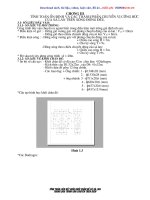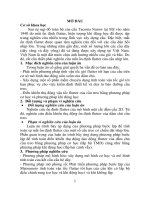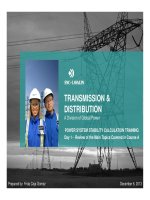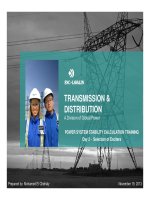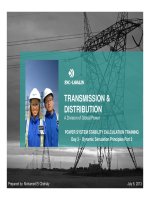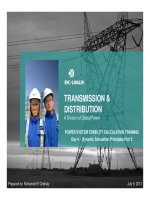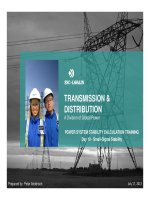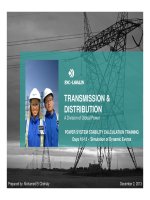Phần 18 KHÓA ĐÀO TẠO TÍNH TOÁN ỔN ĐỊNH VÀ ỨNG DỤNG TRÊN PHẦN MỀM PSSE CHO KỸ SƯ HỆ THỐNG ĐIỆN (Mô hình đường dây Siêu cao áp HVDC trên Phần mềm PSSE)
Bạn đang xem bản rút gọn của tài liệu. Xem và tải ngay bản đầy đủ của tài liệu tại đây (2.97 MB, 57 trang )
TRANSMISSION &
DISTRIBUTION
A Division of Global Power
POWER SYSTEM STABILITY CALCULATION TRAINING
D8
HVDC Si l ti P t 1
D
ay
8
-
HVDC
Si
mu
l
a
ti
on
P
ar
t
1
November 26, 2013Prepared by: Mohamed El Chehaly
eBook for You
OUTLINE
2
OUTLINE
• HVDC Configurations
• HVDC Static Characteristics
• Equivalent HVDC Model in Load Flo
w
CltHVDCMdliLdFl
•
C
omp
l
e
t
e
HVDC
M
o
d
e
l
i
n
L
oa
d
Fl
o
w
eBook for You
3
HVDC CONFIGURATIONS
HVDC
CONFIGURATIONS
eBook for You
Different Configurations
4
HVDC CONFIGURATIONS
Different
Configurations
Monopolar configuration with ground
return
Monopolar configuration with metallic
return
Monopolar configuration with midpoint
grounded
Bipolar configuration with ground return
Bipolar configuration with metallic return
Back-to-back configuration
eBook for You
Mono
p
ola
r
Confi
g
uration with Ground
5
HVDC CONFIGURATIONS
p
g
Return
Simplest and least expensive systems
Earth return gives low losses
Source: ABB
eBook for You
Mono
p
ola
r
Confi
g
uration with Metallic
6
HVDC CONFIGURATIONS
p
g
Return
Used when earth return is not valid
Also, back-up mode in bipolar
transmission if earth return is not allowed
and with one healthy pole
Source: ABB
eBook for You
Mono
p
ola
r
Confi
g
uration with Mid
p
oint
7
HVDC CONFIGURATIONS
p
gp
Grounded
Economic alternative to monopolar
system with metallic return
Two conductors required if ground return
current is not allowed
Source: ABB
eBook for You
Bi
p
olar Confi
g
uration with Ground
8
HVDC CONFIGURATIONS
pg
Return
Most common configuration with 12-pulse
converters
Balanced operation gives zero earth
current and low transmission losses
Source: ABB
eBook for You
Bi
p
olar Confi
g
uration with Metallic
9
HVDC CONFIGURATIONS
pg
Return
More expensive than previous solution
Case if no earth return is possible
Balanced o
p
eration
g
ives zero earth
pg
current and low transmission losses
Source: ABB
eBook for You
Back
to
Back Configuration
10
HVDC CONFIGURATIONS
Back
-
to
-
Back
Configuration
Used for interconnection of asynchronous
networks
No transmission line is necessary
Two converter stations in the same
geographical location
Source: ABB
eBook for You
11
HVDC STATIC
HVDC
STATIC
CHARACTERISTICS
eBook for You
Basic Rectifier Static Characteristics
12
HVDC STATIC CHARACTERISTICS
Basic
Rectifier
Static
Characteristics
Static control and operation of HVDC links
With HVDC transmission, one terminal sets the
DC voltage level while the other regulates the DC
current
current
Since the DC line resistance is low, large changes
in current
(
and
p
ower
)
can be made with relativel
y
(p ) y
small changes in firing angle
Two methods to control DC output voltage
Bh ith tibt thDClt dth
B
y c
h
ang
i
ng
th
e ra
ti
o
b
e
t
ween
th
e
DC
vo
lt
age an
d
th
e
AC voltage by varying the delay angle α
By changing the converter AC voltage via load tap
h
c
h
angers
eBook for You
Basic Rectifier Static Characteristics
13
HVDC STATIC CHARACTERISTICS
Basic
Rectifier
Static
Characteristics
Constant minimum firing angle control
(α
min
)
Constant current control (I
order
)
Current is kept constant with voltage variation by
varying the firing angle
AB: alpha min
BC: constant current
characteristic
Source: Alstom
eBook for You
Basic Rectifier/Inverter Static
14
HVDC STATIC CHARACTERISTICS
Characteristics
Rectifier operation: firing angle below 90°
Inverter operation: firing angle above
90°(extinction angle γ)
AB: alpha min
BC XC: constant current
BC
,
XC:
constant
current
Characteristic
XY: gamma min
Source: Alstom
eBook for You
Basic Re
q
uirements of the Converter
15
HVDC STATIC CHARACTERISTICS
q
Control System
Rectifier control
Normally operated in DC current control
If the rectifier’s AC terminal voltage is insufficient,
the rectifier will operate with alpha min control
Inverter control
Normally operated in constant gamma control
Normally
operated
in
constant
gamma
control
If the rectifier is unable to deliver the required DC
current, the inverter will operate with the DC
current control
Source: Alstom
eBook for You
Basic Re
q
uirements of the Converter
16
HVDC STATIC CHARACTERISTICS
q
Control System
Flow from converter A to converter B
Flow
from
converter
A
to
converter
B
AB: alpha min
BC: constant current
Characteristic
XY: constant gamma
WX: resulted current
from inverter
from
inverter
OP: operating point
Source: Alstom
eBook for You
Basic Re
q
uirements of the Converter
17
HVDC STATIC CHARACTERISTICS
q
Control System
Flow from converter B to converter A
Flow
from
converter
B
to
converter
A
Source: Alstom
eBook for You
Firing Angle Characteristics
18
HVDC STATIC CHARACTERISTICS
Firing
Angle
Characteristics
A: Variable
α
i
and constant V
AC
A:
Variable
α
m
i
n
and
constant
V
AC
B: Constant α
min
and variable V
AC
Source: Alstom
eBook for You
Extinction Angle Characteristics
19
HVDC STATIC CHARACTERISTICS
Extinction
Angle
Characteristics
A: Variable γ and constant V
AC
A:
Variable
γ
and
constant
V
AC
B: Constant γ and variable V
AC
Source: Alstom
eBook for You
DC Power Characteristics
20
HVDC STATIC CHARACTERISTICS
DC
Power
Characteristics
A given increase in power order will have
a disproportionate change in DC current
a
disproportionate
change
in
DC
current
order (due to variation in DC voltage)
Source: Alstom
eBook for You
Reactive Power Characteristics
21
HVDC STATIC CHARACTERISTICS
Reactive
Power
Characteristics
When DC power is increased, the reactive
power consumed by the converters is
power
consumed
by
the
converters
is
increased as well
Source: Alstom
eBook for You
22
EQUIVALENT HVDC MODEL IN
EQUIVALENT
HVDC
MODEL
IN
LOAD FLOW
eBook for You
Short
Circuit Level Requirements
23
EQUIVALENT HVDC MODEL IN LOAD FLOW
Short
-
Circuit
Level
Requirements
For LCC
-
HVDC the system must be strong
For
LCC
HVDC
,
the
system
must
be
strong
at the converters
dc
P
S
SCR
min
eBook for You
Short
Circuit Level Requirements
24
EQUIVALENT HVDC MODEL IN LOAD FLOW
Short
-
Circuit
Level
Requirements
Strong system if SCR > 3.0
eBook for You
Reactive Power
25
EQUIVALENT HVDC MODEL IN LOAD FLOW
Reactive
Power
LCC-HVDC converters consume reactive
power at both ends
Reactive power requirements ≈ 50% of
P
rated
Harmonic filters can provide between 50%
and 100% of the required VARS
eBook for You
